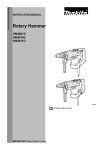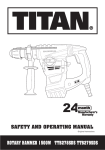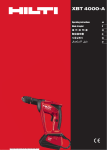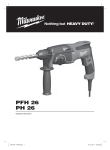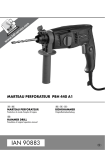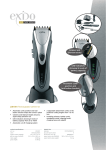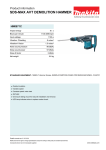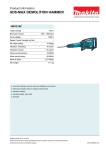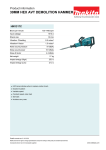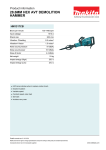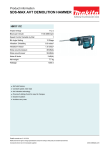Download BA TE15-C englisch
Transcript
*308372* 308372 TE15-C Operating instructions Mode d’emploi Manual de instrucciones General safety rules 1. WARNING! Read and understand all instructions. Failure to follow all instructions listed below may result in electric shock, fire and/or serious personal injury. SAVE THESE INSTRUCTIONS 2. Work Area 2.1 Keep your work area clean and well lit. Cluttered benches and dark areas invite accidents. 2.2 Do not operate power tools in explosive atmospheres, such as in the presence of flammable liquids, gases, or dust. Power tools create sparks which may ignite the dust or fumes. 2.3 Keep bystanders, children and visitors away while operating a power tool. Distractions can cause you to lose control. 3. Electrical Safety 3.1 Grounded tools must be plugged into an outlet properly installed and grounded in accordance with all codes and ordinances. Never remove the grounding prong or modify the plug in any way. Do not use any adaptor plugs. Check with a qualified electrician if you are in doubt as to whether the outlet is properly grounded. If the tools should electrically malfunction or break down, grounding provides a low resistance path to carry electricity away from the user. Applicable only to Class I (grounded) tools. 3.2 Double insulated tools are equipped with a polarized plug (one blade is wider than the other). This plug will fit in a polarized outlet only one way. If the plug does not fit fully in the outlet, reverse the plug. If it still does not fit, contact a qualified electrician to install a polarized outlet. Do not change the plug in any way. Double insulation Z eliminates the need for the three-wire grounded power cord and grounded power supply system. Applicable only to Class II tools. 3.3 Avoid body contact with grounded surfaces such as pipes, radiators, ranges and refrigerators. There is 2 an increased risk of electric shock if your body is grounded. 3.4 Don’t expose power tools to rain or wet conditions. Water entering a power tool will increase the risk of electric shock. This instruction need not be provided for tools classified watertight or splashproof. 3.5 Do not abuse the cord. Never use the cord to carry the tools or pull the plug from an outlet. Keep cord away from heat, oil, sharp edges or moving parts. Replace damaged cords immediately. Damaged cords increase the risk of electric shock. 3.6 When operating a power tool outside, use an outdoor extension cord marked «W-A» or «W». These cords are rated for outdoor use and reduce the risk of electric shock. 4. Personal Safety 4.1 Stay alert, watch what you are doing and use common sense when operating a power tool. Do not use a tool while tired or under the influence of drugs, alcohol, or medication. A moment of inattention while operating power tools may result in serious personal injury. 4.2. Dress properly. Do not wear loose clothing or jewelry. Contain long hair. Keep your hair, clothing, and gloves away from moving parts. Loose clothes, jewelry, or long hair can be caught in moving parts. 4.3 Avoid accidental starting. Be sure switch is off before plugging in. Carrying tools with your finger on the switch or plugging in tools that have the switch on invites accidents. 4.4 Remove adjusting keys or wrenches before turning the tool on. A wrench or a key that is left attached to a rotating part of the tool may result in personal injury. 4.5 Do not overreach. Keep proper footing and balance at all times. Proper footing and balance enables better control of the tool in unexpected situations. 4.6 Use safety equipment. Always wear eye protection. Dust mask, non-skid safety shoes, hard hat or hearing protection must be used for appropriate conditions. 5. Tool Use and Care 5.1 Use clamps or other practical way to secure and support the workpiece to a stable platform. Holding the workpiece by hand or against your body is unstable and may lead to loss of control. 5.2 Do not force tool. Use the correct tool for your application. The correct tool will do the job better and safer at the rate for which it is designed. 5.3 Do not use tool if switch does not turn it on or off. Any tool that cannot be controlled with the switch is dangerous and must be repaired. 5.4 Disconnect the plug from the power source before making any adjustments, changing accessories, or storing the tool. Such preventive safety measures reduce the risk of starting the tool accidentally. 5.5 Store idle tools out of reach of children and other untrained persons. Tools are dangerous in the hands of untrained users. 5.6 Maintain tools with care. Keep cutting tools sharp and clean. Properly maintained tools with sharp cutting edges are less likely to bind and are easier to control. 5.7 Check for misalignment or binding of moving parts, breakage of parts and any other condition that may affect the tools operation. If damaged, have the tool serviced before using. Many accidents are caused by poorly maintained tools. 5.8 Use only accessories that are recommended by the manufacturer for your model. Accessories that may be suitable for one tool may become hazardous when used on another tool. 6. Service 6.1 Tool service must be performed only by qualified repair personnel. Service or maintenance performed by unqualified personnel could result in a risk of injury. 6.2 When servicing a tool, use only identical replacement parts. Follow instructions in the Maintenance section of this manual. Use of unauthorized parts or failure to follow Maintenance Instructions may create a risk of electric shock or injury. Additional Specific Safety Rules: 101 Hold tools by insulated gripping surfaces when performing an operation where the cutting tool may contact hidden wiring or its own cord. Contact with a «live» wire will make exposed metal parts of the tool «live» and shock the operator. 102 Wear ear protectors when using the tool for extended periods. Prolonged exposure to high intensity noise can cause hearing loss. Hilti TE15-C Rotary Hammer Drill Technical data 1 2 Double insulation 3 Always wear ear protectors. Always wear protective gloves. Always wear safety glasses. Input power: 710 W Voltage (versions): 120 V Input current: 6.3 A Frequency: 50–60 Hz Speed under load: 0–730/min. Hammering under load: 0–3850 blows/min. Single impact energy: 2.2 Joules / 1.6 ft-lbs. Drill bit size range: 4–28 mm dia. / 3/16″–11/8″ dia. Optimal performance dia.: 10–16 mm / 3/8″–5/8″ Drilling performance in medium-grade concrete with 12 mm dia. drill: 42 cm3/min. 370 mm/min. / 110 in3/min. Chiselling performance in medium-hard concrete with pointed chisel: 180 cm3/min. Chuck type: TE-C Drill bit connection end: TE-C Automatic cut-out brushes Double insulation construction With slip clutch Dust-tight enclosure, central and permanent lubrication (maintenance free) Variable speed switch Side handle adjustable with depth gauge Forwards/reverse switch Right of technical modifications reserved 4 This Product is UL listed and CSA certified R Do not use this product in any way other than as directed by these operating instructions. The respective regulations of your trade association and the enclosed safety precautions must be observed. The operating instructions should always be kept with the machine! 3 Please note before start-up 1. The electric supply must comply with the data printed on the machine’s rating plate. 2. This machine is double insulated and may not be grounded (earthed). 3. Do not exert undue pressure on the machine. This will not increase its performance. Just position the bit and guide it into the hole. Lubrication of chuck The chuck is not incorporated in the lubricating system of the machine. The drill bit connection end, therefore, must be cleaned regularly and lubricated sparingly with Hilti grease. Start-up time at low temperatures Start-up time can be reduced by jolting the drill bit against the work surface when switching on. Servicing: Electric tools comply with respective safety regulations. Servicing must, therefore, be carried out only by qualified electrical specialists. For your safety, only use original Hilti spare parts. Operating: Fig. 1: Insertion of drill bit Turn chuck to the left (symbol ( )). Insert drill bit in any position until resistance is felt. Then turn it until it moves in farther. Turn chuck to right and lock drill bit in place (symbol ()). Fig. 2: Rotary hammer drilling Rotary hammer drilling in concrete, masonry and natural stone. Press the red lockbutton on the switching lever. Turn the switching lever to the “rotary hammer drilling” position (symbol ) until the lockbutton engages. 4 Fig. 3: Drilling without hammering action Press the red lockbutton on the switching lever. Turn the switching lever to the “rotary drilling” position (symbol ) until the lockbutton engages. In this position, the insert tool simply rotates with no hammering action. Fig. 4: Chisel adjustment Press the red lockbutton on the switching lever. Turn the switching lever to the “chisel adjustment” position (symbol ) until the lockbutton engages. Fig. 5: Chiselling function Secure the chisel in the desired position and select the chiselling function. Press the red lockbutton on the switching lever. Turn the switching lever to the “chiselling” position (symbol ) until the lockbutton engages and ensure that the forwards / reverse switch is in the forwards position (see fig. 6). Fig. 8: Side handle / depth gauge Unscrew side handle to release depth gauge. Adjust depth gauge and retighten. 5 6 Forwards 7 Fig. 6: Forwards / reverse switch Forwards rotation: Move the lever to the left. Reverse rotation: Move the lever to the right. Fig. 7: Changing the chuck Pull forward sleeve and completely remove chuck. When attaching chuck, pull forward sleeve and hold it there. Press chuck onto guide tube as far as it will go. Release sleeve. Turn chuck until steel balls snap into place. Note: When a key-type chuck or a quickrelease chuck is used, the hammering action is not transmitted to the insert tool (drilling without hammering action). However, for smoother running with less vibration it is recommended that the “drilling without hammering action” position (fig. 3) is selected. 8 Reverse




